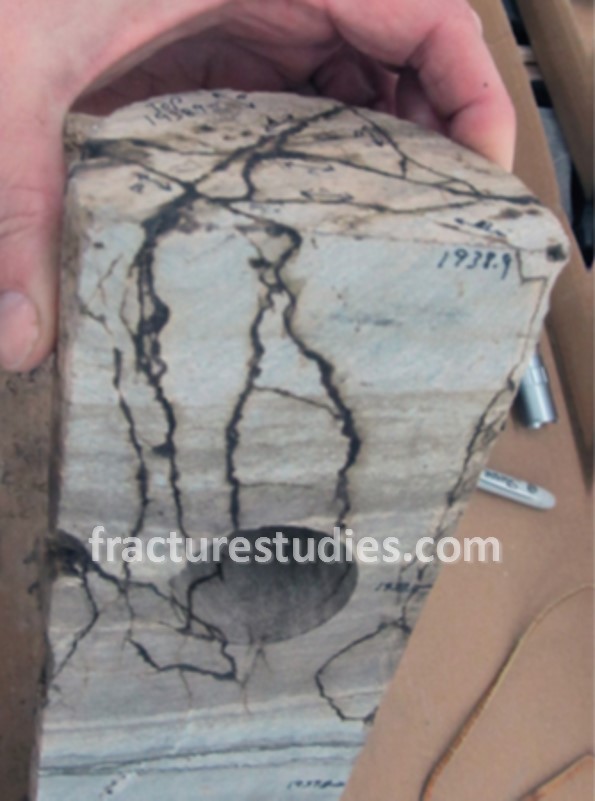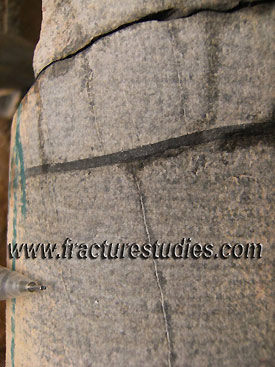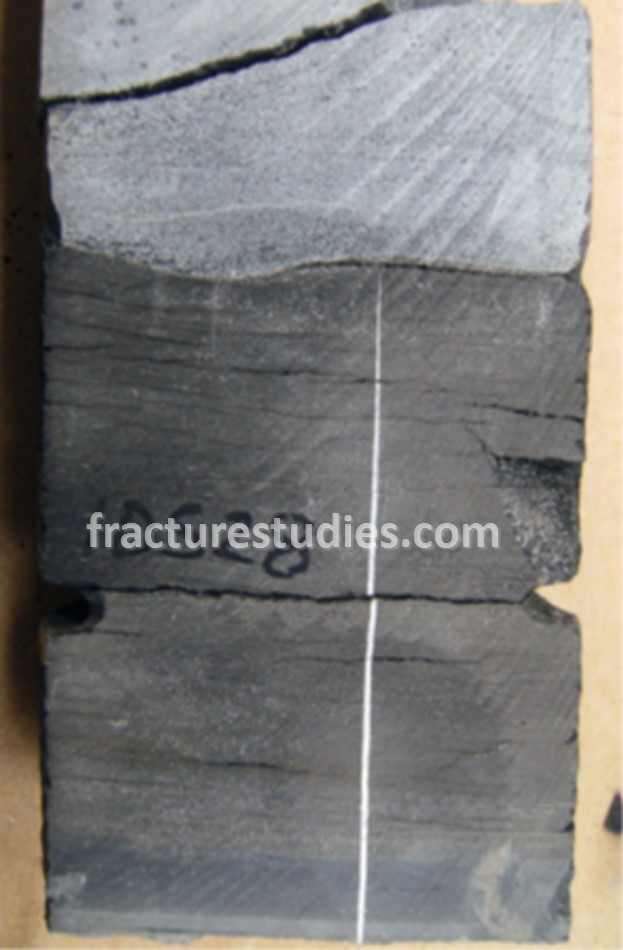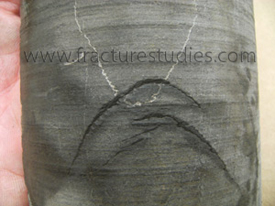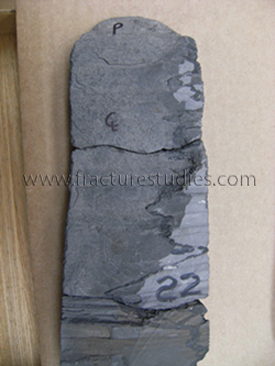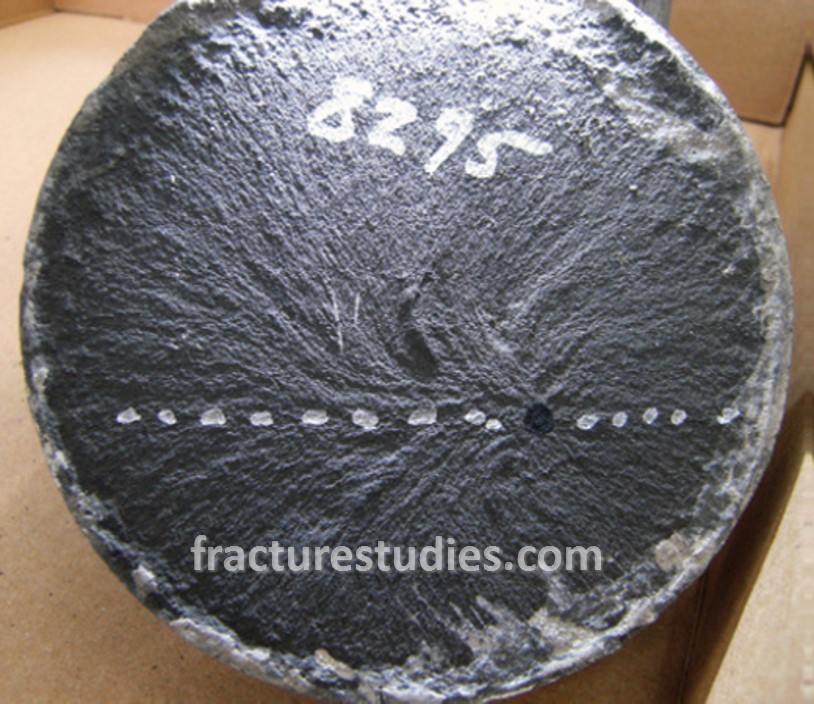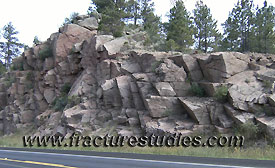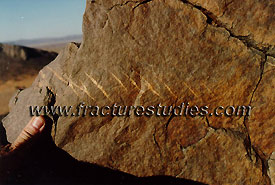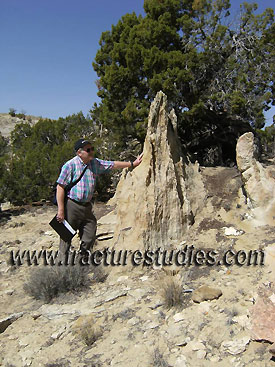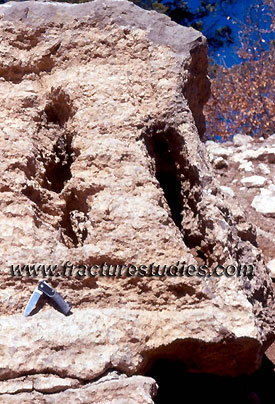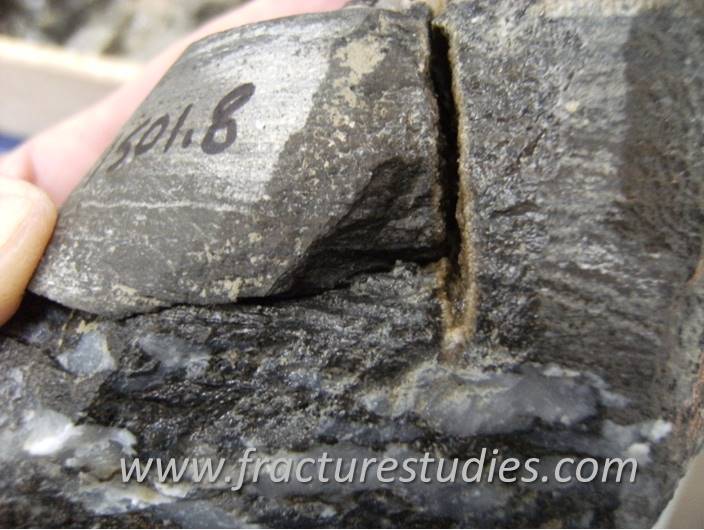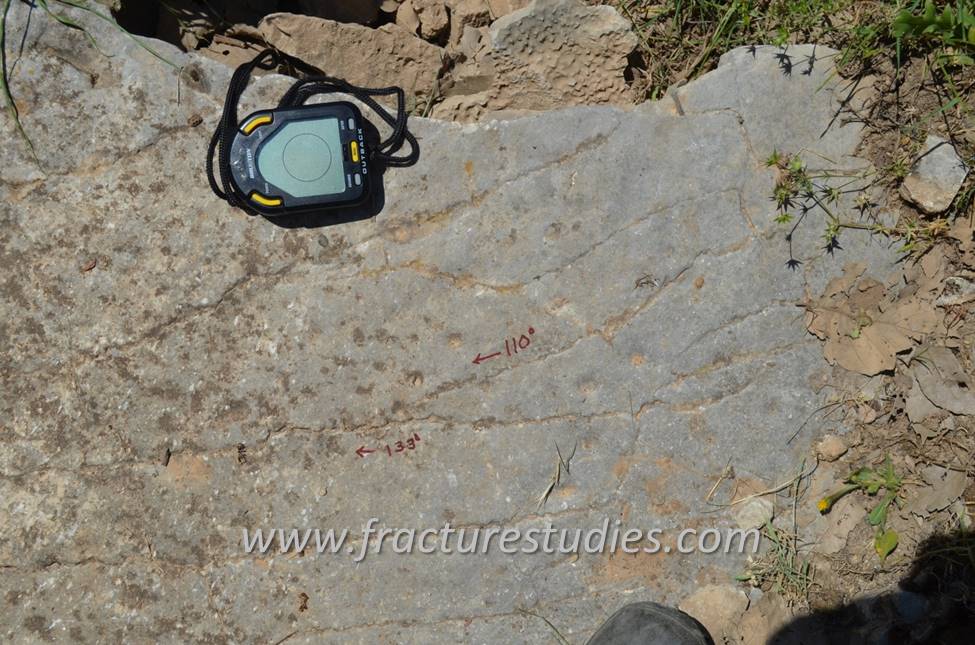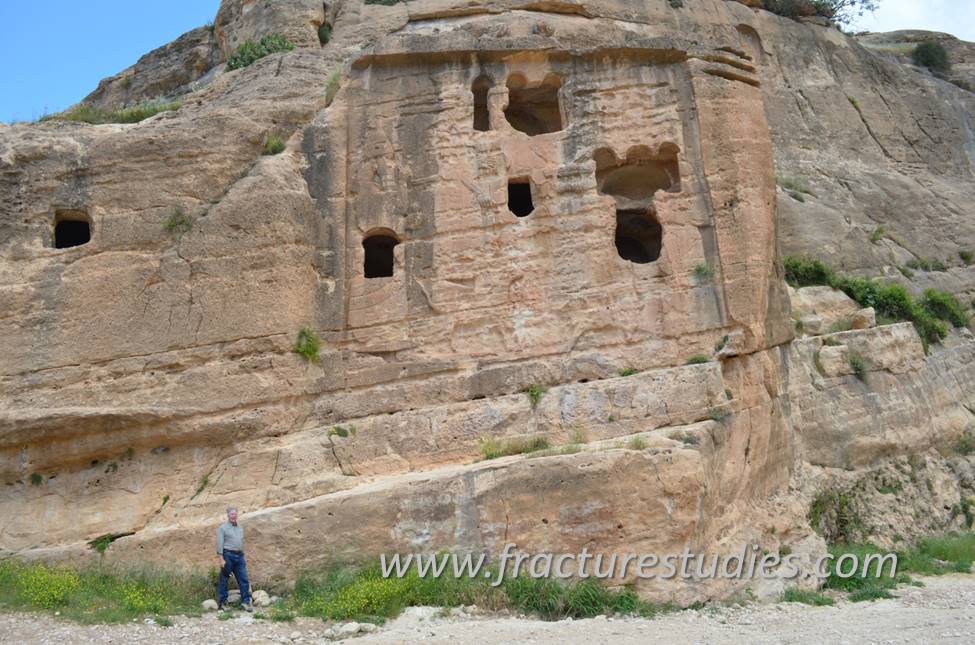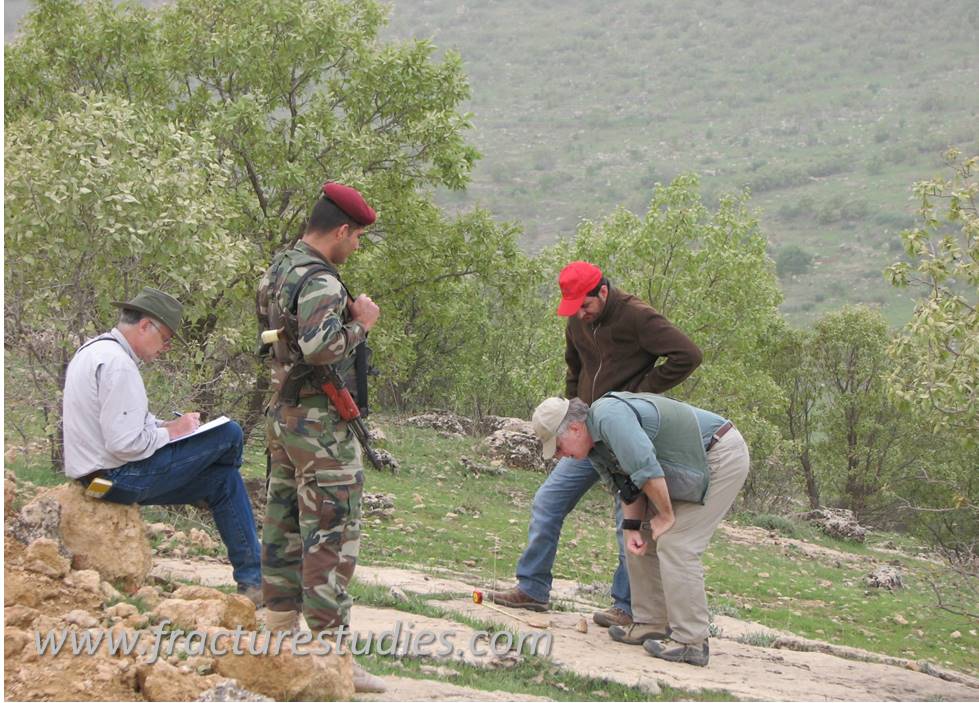Fractures in Core, Future Studies, Discussion TopicsFeatured on this page are examples of fractures in core, potenial fracture studies that we find fascinating and that would be worth pursuing, and some interesting discussion topics. Discussion Topics for Natural Fracture StudiesAlthough natural fractures have been studied for for over a century, there are many topics still under discussion or are outright unknowns. Featured are examples of fracture problems and areas that would make good theses or that are worthy of a proprietary study. Some topics are worth doing just for the good of the science; for example we recently completed an un-funded project organizing and culling over 10,000 photographs of fractures in cores that we have analyzed for clients, publishing the effort as the "Atlas of Natural and Induced Fractures in Core". Fractures in Core: The photographs below illustrate some of the fracture types documented within core and describe some of the geomechanical topics associated with these fractures.
Why we care: fractures provide a permeability pathway for fluids, including hydrocarbons, to move through the rock. The photograph above shows irregular, oil-filled, high-angle extension fractures in a bedded limestone. Vertical four-inch diameter core; uphole is towards the top of the photo.
Different types of rock deform in different ways: the sandstone in this photograph accommodated strain with vertical extension fractures whereas the thin shale parting (dark gray/black material above pencil) deformed in a ductile manner and arrested fracture propagation, limiting vertical fracture-related permeability. Compare this with the photograph below wherein the shale fractured and the limestone arrested fracture propagation.
Mechanical properties can change over geologic time due to diagenesis and changes in pore pressures. Some clay-rich lithologies that are presently relatively ductile were, under different conditions, the more fracture-prone strata in a heterogeneous sequence. In this example, a calcite-mineralized vertical extension fracture in a shale tapers towards its termination against a limestone layer. At the time of fracturing, the shale was more susceptible to fracturing than the limestone. Slab from a vertical three-inch diameter core, uphole is towards the top of the photograph.
Niobrara Formation core showing the parallel strikes of a calcite-mineralized hairline fracture above, and several unmineralized drilling-induced petal fractures, below. Petal fractures form below the core bit due to the weight on bit, and their strikes record the orientation of the maximum in situ horizontal compressive stress (see Lorenz et al., 1991).
Induced petal fracture (P) and its downhole extension centerline fracture (CL), that intersect the slab face (the lighter-colored, irregularly shaped plane on the right of the photo) at a small oblique angle. These induced fractures strike nearly normal to the overall strike of the irregular stylolitized injection that extends vertically along the right side of the core. Since the induced fractures strike parallel to the maximum horizontal compressive stress, they are geomechanically compatible with the shortening direction indicated by the vertical stylolites.
A horizontal induced fracture: note the lip on the disc fracture at the outer core surface, indicating interaction between the disc plane and the free surface, and that discing formed after the core was cut. Note also the rim of mud invasion next to the core surface, indicating that the mud coating on the core was still wet and mobile at the time of discing. Vertical, 4-inch diameter core; uphole is towards the viewer. Fractures in Granite
Fractures in granite have many localized domains of intersecting and parallel extension fractures (Precambrian, Laramie Mountains, Wyoming). Characterization of the fracture domain distributions would afford predictive capabilities for reservoirs in fractured granites. En Echelon Veins
En echelon veins in silicified sandstone; Ougarta Arch, Algeria. The orientation of these veins, and their occurrence in conjugate sets, indicates that the now-brittle sandstone was ductile and that the horizontal stress exceeded the vertical stress at the time of fracturing. Quantifying the stress conditions and the mechanical properties that control the formation of extension vs. conjugate fractures would be an important step in predictive capabilities. Deformation Bands
An unmineralized bundle of deformation bands in a shear zone forms a resistant ridge and would be a permeability barrier in a reservoir; fluvial Morrison Formation, New Mexico. Characterizing the distribution of such amalgamated shear bands would provide insights into the distribution of reservoir baffles and offer production strategies for overcoming such difficulties. Dissolution
Fractures in this carbonate outcrop have been preferentially leached out to form slots; Madera Limestone, New Mexico. Much study has been devoted to fracture mineralization. The flip side of the coin, fracture dissolution, is less well studied, but dissolution significantly enhances the effects of fractures on plumbing in many reservoirs.
Fractures in core can also show slot-style dissolution, as in this thin limestone between calcareous shales. The slot originated as an extension fracture and has been widened by dissolution. Calcite was secondarily precipitated on the slot faces after the original fracture had been widened by dissolution. The core is from tilted strata cut by a vertical well; for this photo, the core has been positioned to re-orient the fracture to its pre-fold vertical position and bedding to its pre-fold horizontal position. Kurdistan
A limestone bedding plane in the Eocene Pila Spi Formation contains two sets of bed-normal stylolites. Stylolite orientations show that in this area of Kurdistan there were two phases of compression, with the maximum compressive stress lying in the plane of bedding and trending normal to the stylolites, i.e., about NE-SW and NNE-SSW. This is compatible with the orientations and geometries of the several sets of extension and conjugate shear fractures in the area.
Assyrian ruins at Khanis, Kurdistan. The bas-relief sculptures cut into limestones of the Pila Spi Formation are accompanied by cuneiform inscriptions. The aqueduct that began at this site diverted water from the local river 100 kilometers across the plains to the city of Nineveh, near present-day Mosul.
Many fracture widths in the limestones exposed at the surface in Kurdistan have been enhanced by weathering during the wet winters, and later filled with mud and grass. General fracture strikes can be measured, but little else. Field work in Kurdistan requires an awareness of minefields and various armed political entities.
|
Contact UsScott P. Cooper John C. Lorenz |
